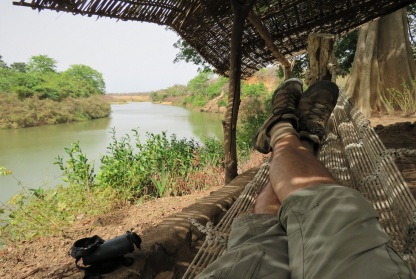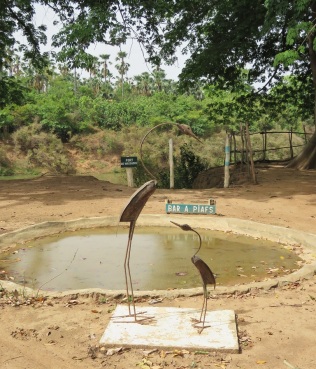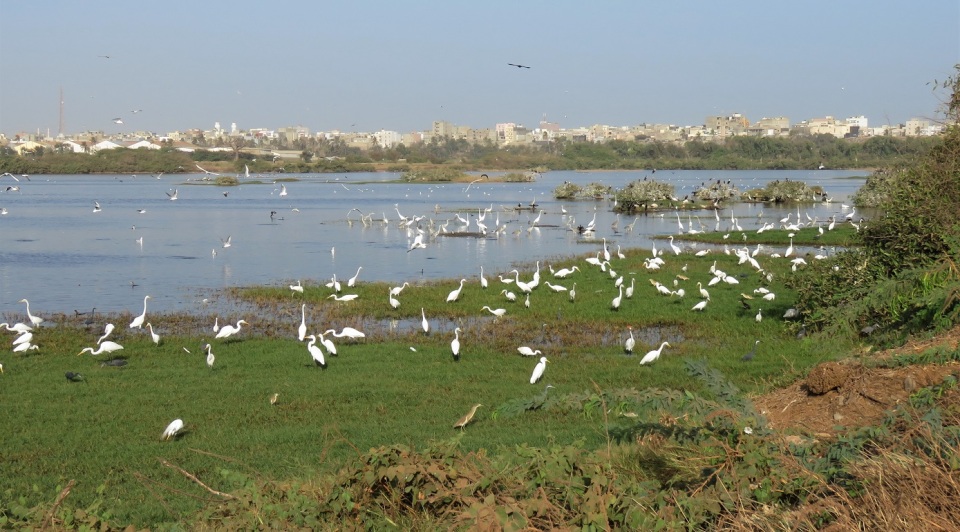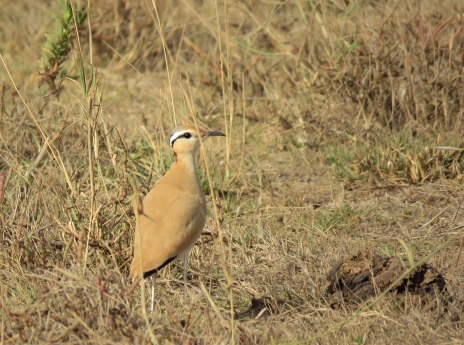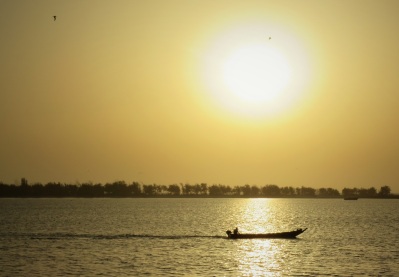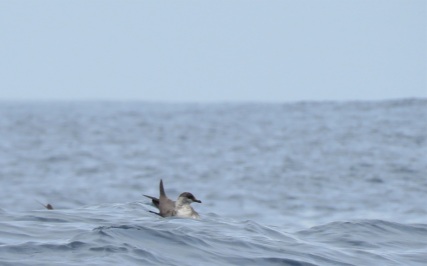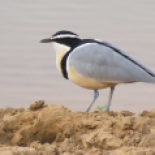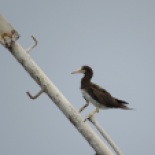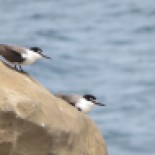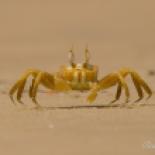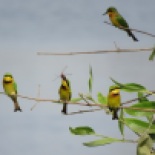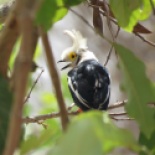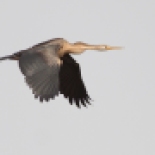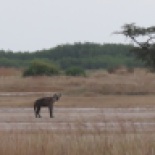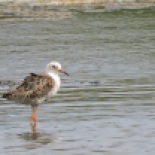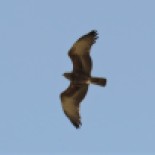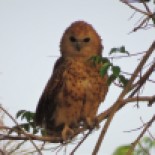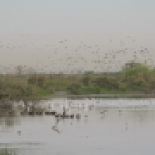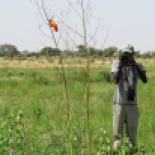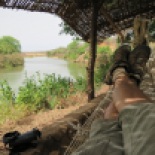Au revoir la Teranga
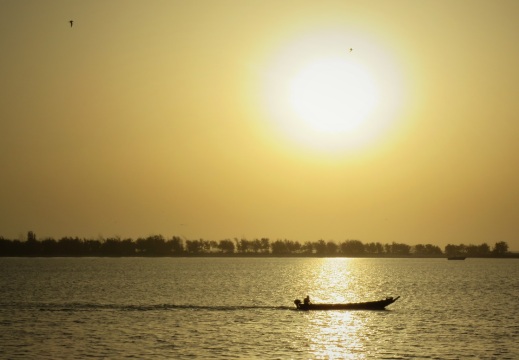
Our regular readers will have noticed that it’s been very quiet on this blog in recent months, so it’s about time I published an update here. There’s a simple reason for the lack of recent posts: after just over five years in Dakar, it was time to move on. Three weeks ago we landed in Laos where we will be based for the foreseeable future, marking the start of a new adventure here in Vientiane. And the end of a pretty amazing experience living in Senegal.
Moving on is of course bittersweet, as I will certainly miss the fabulous bird life that Senegal has to offer, yet at the same time I’m excited to discover the birds and culture of Laos. Even if we’re currently living in rather unsettling and unpredictable times, to say the least. Many of you will be reading this while confined at home, but being extremely busy with my work here I’ll need to keep it short… somehow writing this post is actually the one that I’ve struggled the most with so far – it’s been sitting in my drafts for about three weeks now.
Over the past five years I managed to visit all but one of the country’s regions – sadly I never made it to Matam! – and was lucky to see a good deal of its birds, 530 species to be precise, 527 of which I saw during 2015-2020. A few other numbers: some 52,500 records “collected”, four additions to the country list, about 1,040 sound recordings posted on xeno-canto, tons of poor quality bird photographs, countless happy hours in the field…
There are of course a few specials that I didn’t get to track down, such as Golden and Egyptian Nightjar, White-throated Francolin or Denham’s Bustard to name but a few, and I somehow managed to never visit Kousmar (pretty unbelievable right?) and the Niokolo-Kobo proper (I was happy enough exploring Wassadou on three occasions), but these are all good reasons to one day come back of course. That said, I’m not very optimistic about the state and future of Senegal’s environment, and while this is not the time to expand on this, there have been many frustrating, sad and upsetting moments when confronted on an almost daily basis with the ongoing destruction of natural habitats, with the ever-increasing pollution levels, and with the population’s general indifference and ignorance when it comes to nature and wildlife conservation.
Senegal certainly has treated us well and I feel privileged to have had the chance to explore the country these past few years. I tried to promote birding in Senegal and think I made some modest contributions to the “body of ornithological knowledge” both through this blog (149 posts!) and through a number of papers, 14 to be precise, something we’ll try to continue doing in coming months (years?). The absence of recent posts on SenegalWildlife is definitely not for a lack of ideas or material… just need to find the time to write up stuff, be it here in these pages or elsewhere.
Lots of good memories, of encounters with birds of course but also of places and people, too many to start listing here. Unexpected finds, and some unexpected birding settings.
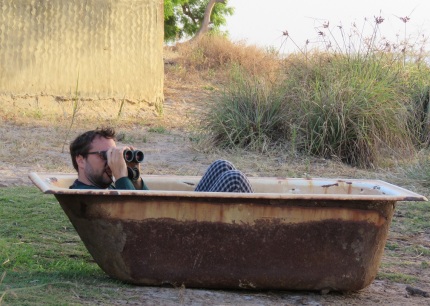
Birding the Saloum delta (yes that’s me in my pyjamas in a bath tub on the edge of a mud flat, one of those randomly surreal settings one may find oneself in… only in Senegal!) – Picture by Jane Piot
Despite the crazy busy few weeks leading up to our departure from Dakar, I was of course keen to go back out to some of my favourite spots: Popenguine, Technopole, Mbeubeusse, Lac Rose, and of course Le Calao for my daily dose of seawatching.
And as always there were some good birds to be seen here, some of which were quite unexpected. During my last visit at Technopole on the morning of our departure (8.3), a pair of Eurasian Teals was a nice find. My final ring reading here was of a French Eurasian Spoonbill ringed in the Camargue colony in 2016… with now +600 ring readings in my little database, there’s definitely enough material to write up another post on this topic. An immature Brown Booby on 21.2 and 5.3 at Ngor was pretty classic at this time of the year. Much less expected was a fine Cream-coloured Courser on the steppe near lac Rose on 20.2, apparently the first record for the Dakar region. It was loosely associating with a few Temminck’s Coursers, a classic species here, just like the handful of Greater Short-toed Larks that were present the same day. A few days earlier, a Temminck’s Stint at Mbeubeusse (16.2) was yet another scarce migrant to show up at this prime location for waders. And during our last visit to Popenguine (23.2) a Chestnut-crowned Sparrow-Weaver was a good record from this location, of a species that is rarely reported away from the south-east and that in fact I’d only seen once before in Senegal, near Kedougou.
Thanks to our followers and regular readers.
Take care, stay safe, flatten that curve.
Au revoir le pays de la Teranga, à la prochaine!
Seawatching Ngor – August 2019

An update on this autumn’s seabird migration at Ngor is long overdue, so here we set off the season’s summary with the month of August. I managed to count migrants during 18 hours spread out over 16 sessions, starting with the first on August 9th, straight after coming back to Dakar from a short break Up North. As usual I tried to do relatively brief sessions (usually about an hour) as often as possible, typically early morning about an hour after sunrise. And always from the Club Calao terrace, of course.
With some 7,100 birds counted, numbers passing through during August were about average in comparison with previous years. The few highlights so far were a Great Shearwater (Puffin majeur) flying SW on the 10th which I believe is the first August record, more than usual ‘Macaronesian’ Shearwaters (=Boyd’s or Barolo, Puffin “de Macaronésie”) with no less than 21 birds spread out fairly evenly throughout the period, and again a decent amount of Long-tailed Skuas (Labbe à longue queue). So far, 226 of these elegant pelagic skuas passed through, compared to 213 in August 2018; last year a record 500 were logged during the entire season. Top day was the 20th when I counted a very honorable 84 birds in just one hour, surprisingly during modest NNW wind – always impressive seeing loose flocks of up to 15-20 birds, usually including several adults. None were seen the following two days but during 24-26th there were 89 in 4h35′. Last year the peak passage was during the first decad of September when no less than 217 were counted in just 75′ on 2.9.18, so it’s possible that quite a few more Long-tails will pass through in coming weeks, though this will in part depend on wind conditions: moderate to strong winds from W to NW are usually required to see this species in double or even triple digits (in 2017, hardly any were seen, as shown in the chart below where the dashed line is 2017 and the dotted line 2018; solid line is hourly average per decad).

Other pelagics included early Sooty Shearwaters (Puffin fuligineux) with seven birds during 24-26 August, and three Sabine’s Gulls (Mouette de Sabine) on the 20th. September and October should see many more of these two species! In contrast with last year when more than a thousand birds were seen in August when conditions were good for this species, just three Red Phalaropes (Phalarope à bec large) were detected this past month, though I had the first small flock this morning Sept. 1st, about 15 towards the SW and one coming in from the N and landing at sea. Of course many must have passed through these past few weeks, just too far off-shore for them to be seen from the coast.
What was most likely the same Red-footed Booby (Fou à pieds rouges) was seen daily from 9th-12th, usually flying past at close range and sometimes feeding just behind the surf, with two birds together on Aug. 17th. I also twice saw one in July so it’s quite possible that at least one of these two immatures – both dark morph, as all others seen so far – oversummered around the peninsula.
As usual, the most frequently seen wader was Whimbrel, with just a handful of Oystercatchers and Bar-tailed Godwits each (Courlis corlieu, Huîtrier pie, Barge rousse). The lower number of waders compared to the past few years is probably due to the late arrival of the rains and a four-day gap in my presence during the last week of the month (waders tend to be seen mostly during and just after spells of rain here).
The table below lists all species with totals for the month, with 2017 and 2018 numbers to compare with. Note that the vast majority of the ‘Comic’ Terns were Arctic, and the higher number of Roseate Terns is possibly explained by the fact that I may feel more confident identifying these birds (Sterne arctique/pierregarin, Sterne de Dougall). Oftentimes, Roseates are migrating 2-3 birds together, usually mixed in with Arctic Terns.
Species |
2019 |
2018 |
2017 |
| Wilson’s Storm-Petrel | 0 | 157 | 0 |
| Cape Verde Shearwater | 0 | 100 | 1 |
| Great Shearwater | 1 | 0 | 0 |
| Sooty Shearwater | 7 | 0 | 0 |
| Boyd’s/Barolo Shearwater | 21 | 3 | 0 |
| Shearwater sp. | 3 | 6 | 4 |
| Red-footed Booby | 2 | 0 | 0 |
| Oystercatcher | 8 | 8 | 6 |
| Whimbrel | 127 | 340 | 437 |
| Bar-tailed Godwit | 6 | 1 | 49 |
| Turnstone | 0 | 4 | 13 |
| Red Knot | 0 | 28 | 0 |
| Ruff | 0 | 1 | 5 |
| Sanderling | 0 | 0 | 16 |
| Curlew Sandpiper | 0 | 0 | 4 |
| Little Stint | 0 | 0 | 4 |
| Grey (Red) Phalarope | 3 | 1,123 | 0 |
| Common Sandpiper | 0 | 7 | 1 |
| Common Redshank | 1 | 1 | 1 |
| Audouin’s Gull | 7 | 0 | 0 |
| Lesser Black-backed Gull | 0 | 0 | 1 |
| Yellow-legged Gull | 0 | 1 | 0 |
| Large gull sp. (prob. Kelp Gull) | 1 | 0 | 2 |
| Slender-billed Gull | 1 | 0 | 1 |
| Sabine’s Gull | 3 | 12 | 6 |
| Arctic/Common Tern | 3,878 | 4,500 | 1,399 |
| Roseate Tern | 56 | 44 | 10 |
| Little Tern | 23 | 56 | 28 |
| Sandwich Tern | 462 | 343 | 463 |
| Lesser Crested Tern | 4 | 40 | 41 |
| African Royal Tern | 342 | 585 | 166 |
| Caspian Tern | 10 | 14 | 1 |
| White-winged Tern | 0 | 1 | 0 |
| Black Tern | 1,803 | 2,160 | 774 |
| Bridled Tern | 0 | 4 | 0 |
| Catharacta Skua sp. | 0 | 0 | 1 |
| Pomarine Skua | 3 | 1 | 2 |
| Arctic Skua | 59 | 94 | 24 |
| Long-tailed Skua | 226 | 213 | 25 |
| Skua sp. | 46 | 18 | 17 |
| Total birds | 7,103 | 9,865 | 3,502 |
| Number of days | 16 | 22 | 13 |
| Number of hours | 18h05′ | 26h20′ | 17h05′ |
Meanwhile at Technopole, the lagoons are finally starting to fill up again now that we’ve had a few decent showers, though a lot more will be needed to ensure that the site remains wet all through the dry season. There’s a good diversity of waders again and breeding activity is at its peak for many of the local species. Striated Heron for instance is now very visible, and last Sunday I saw a pair feeding a recently fledged young at the base of one of the Avicennia stands on the main lagoon, while Spur-winged Lapwing juveniles are all about, Zitting Cisticolas are busy tending their nest, and this morning a small flock of juvenile Bronze Mannikins was seen (Héron strié, Vanneau éperonné, Cisticole des joncs, Capucin nonnette).
Several wader species are starting to pass through again, such as Common Ringed Plover, Little Stint, Curlew Sandpiper and Marsh Sandpiper (Grand Gravelot, Bécasseau minute, Bécasseau cocorli, Chevalier stagnatile). It’s also peak season for Ruff, with a very modest max. so far of 148 counted this morning (Combattant varié).
On the gulls & terns front, a Mediterranean Gull was still around on 18 & 25.8, probably one of the two immatures that were seen in May-July and apparently completing its summer stay here (these are the first summer records for the species in Senegal), while the first juvenile Audouin’s Gulls of the year were also seen last Sunday, Aug. 25th (Mouette mélanocéphale, Goéland d’Audouin, . This morning a White-winged Tern was of note, as were 24 Little Terns resting with the other terns or feeding above the main lake (Guifette leucoptère, Sterne naine). Three Orange-breasted Waxbills and three Long-tailed Nightjars on 11.08 were far less expected (Bengali zebré, Engoulevent à longue queue).
This morning’s eBird checklist has all the details.
The Great Re-Tern

April is Tern month!
From mid-March into May, lots of terns pass through Dakar on their way back home from the wintering grounds further south – some as far as South Africa! – and the first half of April is definitely peak time for many species. When conditions are right, literally thousands of these elegant birds may pass through on a single day, and sites such as Technopole can hold several hundreds of birds at any one time. So much that in the past week, I’ve had the chance to see 12 out of the 14 tern species that are known to occur in Senegal, the only ones missing being Bridled and the rare Sooty Tern.
On Monday 8.4 at Technopole, decent numbers of terns were about, mainly Sandwich Tern (+300, likely quite a bit more) with a supporting cast of the usual Caspian and Gull-billed Terns (the former with several recently emancipated juveniles, likely from the Saloum or Casamance colonies), but also several dozen African Royal Tern, a few Common Terns, at least two Lesser Crested, and as a bonus two fine adult Roseate Terns roosting among their cousins. And as I scanned one of the flocks one last time before returning back home, an adult Whiskered Tern in breeding plumage, already spotted the previous day by Miguel. I managed to read four ringed Sandwich Terns but far more were wearing rings, but were impossible to read.
Yesterday 13.4, we went back to our favourite urban hotspot mainly in order to see if we could read some more of these rings. The main roost is close to the northern shore of the main lagoon, quite close to golf club house, which makes it possible to get close enough to the birds to read most rings. We saw most of the same tern species (except Roseate), with the addition of a fine moulting White-winged Tern and a small flock of Little Terns migrating over our heads. The first colour-ringed bird we saw was actually a Gull-billed Tern, but not the usual Spanish bird (“U83”) ringed in 2009 and seen several times herein the past three winters. This bird was even more interesting, as it was ringed in the only remaining colony in northern Europe, more precisely in the German Wadden Sea. Awaiting details from the ringers, but it’s quite likely that there are very few (if any!) recoveries of these northern birds this far south. It may well be the same bird as one that we saw back in November 2018 at lac Mbeubeusse, though we didn’t manage to properly establish the ring combination at the time.
So, back to our ring readings: all in all, we managed to decipher an impressive 14 Sandwich Tern rings – blue, white, yellow & red! – of birds originating from no less than four countries: Ireland, UK, Netherlands, and one from Italy (to be confirmed). Most of these are chicks that were born in summer 2016 and that logically spent their first two years in the Southern Hemisphere, and are now returning back to their breeding grounds for the first time. In addition, a Black-headed Gull with a blue ring proved to be a French bird ringed as a chick in a colony in the Forez region (west of Lyon) in 2018, while a Spanish Audouin’s Gull was a bird not previously read here. I’ll try to find some time to write up more on our ring recoveries, now that my little database has just over 500 entries!
Others local highlights from these past few days are the Lesser Yellowlegs still at Technopole on 8.4 (but not seen yesterday… maybe it has finally moved on), also a superb breeding plumaged Bar-tailed Godwit, still a few Avocets, plenty of Ruff, Little Stint, Sanderling, Curlew Sandpiper and Dunlin, many of which in full breeding attire. And on 13.4, once again a Franklin’s Gull, but also a rather late Mediterranean Gull and what was probably the regular adult Yellow-legged Gull seen several times since December. Three Spotted Redshanks were also noteworthy as this is not a regular species at Technopole. The Black-winged Stilts are breeding again, and the first two chicks – just a couple of days old – were seen yesterday, with at least two more birds on nests; a family of Moorhen was also a good breeding record.
Full eBird checklist from 13.4 here.
Earlier this week at the Calao was just about as good in terms of tern diversity: again the usual Sandwich Terns which are passing through en masse at the moment, with some LCT’s in the mix, several dozen Common Terns and the odd Roseate Tern hurriedly yet graciously flying past the seawatch spot, and of course more Royal Terns en route to Langue de Barbarie or Mauritanian breeding sites, a lone Caspian Tern, and this time round an even less expected White-winged Tern (and just two Black Terns). Oh and also the first Arctic Tern of the season! The first birds in spring are typically seen at the end of March or first half of April; earliest dates (2015-2018) are 16.3.18 and 25.3.16. The numbers of migrating terns were really impressive here on Saturday 6.4: a rough estimate puts the number of Sandwich and Common Terns passing through at 500 and 1200, respectively, in just two hours.
At Ngor, regular morning sessions have yielded the usual Pomarine and Arctic Skuas, Northern Gannets, as well as a handful of Cape Verde Shearwaters feeding offshore on most days. Sooty Shearwaters passed through in good numbers on 6.4, while last Friday (12.4) was best for Sabine’s Gull: 73 birds in just one hour, so far my best spring count. Also several Long-tailed Skuas and the other day a South Polar or (more likely) a Great Skua was present, a rare spring sighting. All checklists for the recent Calao counts can be found on this eBird page.
Pelagic trip off Ngor

Why would two Portuguese, a Mauritanian, a Cape-Verdian, a French, an American and a Belgian set off on a boat trip one morning in October? Seabirds of course! With Gabriel in town, Bruce over from the US, Miguel and Antonio as motivated as ever to get out of the office and to have some of their BirdLife colleagues strengthen their seabird id skills, it was time to organise our now annual autumn pelagic, on October 1st.
Conditions were perfect to get out on our small boat (organised through Nautilus Diving: merci Hilda!) though probably a bit too calm for active seabird migration. We chose to head straight west to the edge of the continental shelf, rather than try the “trawler area” off Kayar as this is quite a bit more distant from Ngor. Needless to say that expectations were high as is always the case during these rare opportunities to get close views of the treasured tubenoses – storm petrels, shearwaters – skuas and maybe some Grey Phalaropes or Sabine’s Gulls.
A Manx Shearwater zooming past the boat was one of the first pelagic species we got to see, followed by quite a few Sooty Shearwaters (Puffin fuligineux).
Further out, Wilson’s Storm Petrel became the dominant species, with a few dozen birds seen – and probably many more that went undetected – particularly around the upwelling area. Almost all were obviously actively migrating, and we managed to get some good views of several of them as they zoomed past our boat. Of course, several storm petrels remained unidentified, but we did manage to get decent views of at least two European Storm Petrels (though alas no pictures!). The toes projecting beyond the tail that are diagnostic of Wilson’s are more or less visible on the pictures below.
Up next: skuas, or jaegers as our American friends call them. We didn’t see many, with just three Pomarines and just as few Arctic Skuas, as well as an obliging Long-tailed Skua. The latter was an interesting bird that we aged as a third-summer moulting into third-winter plumage. It briefly joined two Pomarine Skuas (second-year birds?) allowing for nice comparisons of size and structure.
Rounding up our seabirds is this Red (Grey…) Phalarope (Phalarope à bec large), the only one we saw during the trip but somehow Bruce managed to get a picture:
As seems to be quite often the case during these pelagic trips, some landbirds were also encountered, in our case European Turtle Dove (Tourterelle des bois) of which we twice saw singles migrating over the ocean (in October 2016, the PAOC pelagic recorded at least three species of passerines, including a migrating Bluethroat). One of our doves had a very worn and messy plumage, probably a moulting young bird:
Our complete eBird checklist, expertly compiled by Miguel, can be found here. We really ought to add the Osprey that can just about be seen sitting on top of the Almadies lighthouse, but which was noticed only later on this neat picture by Bruce of the lighthouse – Africa’s westernmost building, constructed some time in the 19th century (precise date seems unknown?) on a reef that lies just off the Pointe des Almadies.
Many thanks to Antonio and Bruce for sharing their pictures!

